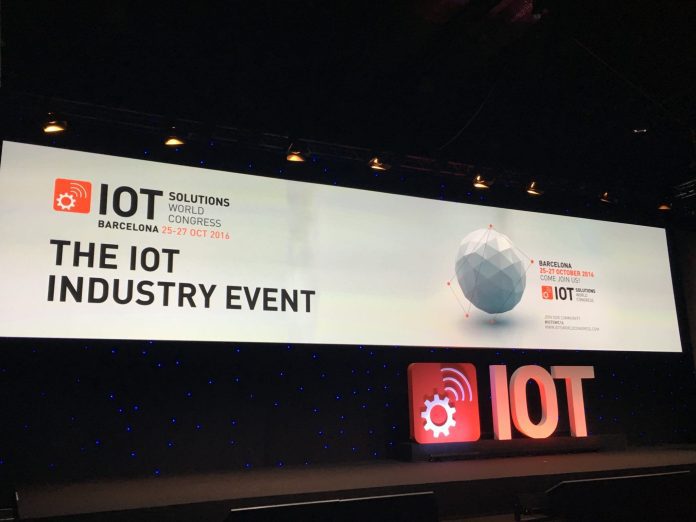Partnerships, ecosystems and platforms took center stage as the IoT industry gathered at IoT Solutions World Congress in Barcelona this week.
The organizers of Internet of Things (IoT) conference IoT Solutions World Congress, held in Barcelona between 25-27 October, have every reason to rejoice. The second edition of the global event recorded a doubling in both the number of attendees and exhibitors, reaching 8,000 and 170 respectively. As the show floor was buzzing with activity, the many keynotes and breakout sessions were well-attended, and offered a somehow unified outlook on the IoT industry. In fact, speakers were rather cautiously upbeat, underlining the long-term potential of an industry in the making and the need to consider customer needs and their complexity rather than hyping statistics on how many gazillion devices will be connected in the future. (Wait, numbers of connected things and volumes of data did somehow manage to get mentioned in the process).
Platforms, ecosystems and partnerships
It would be quicker to count the number of presentations where the concepts of platforms, ecosystems and partnerships were not mentioned rather than the opposite. These three buzzwords mirror the fact that IoT players have come to the realization that delivering IoT solutions requires collaboration among platform and solutions vendors. Prytt Banerjee, European vice president and chief technology officer at Schneider Electric summed it up bluntly – and correctly: ”Anyone who tells you they have the whole solution is either deluded or they are a lier.” There you have it: if your organization is interested in the IoT opportunity, get ready to collaborate. Interestingly, platforms, ecosystems and partnerships are three areas where internet companies, IT vendors and cloud infrastructure providers have displayed strength in recent years, as opposed to telecommunications operators, although these have put quite a lot of efforts into it. Fighting for relevance at the service level in the consumer space, operators might indeed be about to face similar challenges in the industrial IoT space, as IT vendors, cloud providers and indeed industrial players build services alliances and ecosystems.
The industrial IoT industry needs an iPhone
The need for collaboration is just as high within end-users organizations themselves because IoT solutions will call for new business and operational models and involve multiple parties within the same organization. There, one of the main challenges will have to do with having informations technology (IT) and operations technology (OT) work together. Organizational and business considerations will play a key role in technology decisions. Smartphones had been around for a while but it took the iPhone and its platform thinking, not to forget Android, to drive smartphone adoption. Now, it looks improbable today that a convergent IoT platform ”that rules them all” could emerge as so many processes and technologies are at play in every single vertical industry, but interoperability between solutions and platforms will provide valuable help in realizing the industrial IoT vision. That is, when businesses are ready for it. Indeed, according to the World Economic Forum, only 12 percent of technology leaders around the world say they are ready for the fourth industrial revolution.
Industrial companies ahead of the game
Historically, traditional industrial companies may not be have been early adopters of technology, but when it comes to embarking on digital transformation and seizing the industrial IoT opportunity, quite a few players in the IT and telecommunications industry could learn a thing or two from the likes of Bosch and GE. Now positioned as digital industrial companies, the two global industrial heavyweights have used their own digital transformation journey and their own automation challenges to develop platforms and technologies that other industrial players, in other vertical industries, can deploy. In fact, both Bosch and GE have adopted a platform, ecosystem and partnership thinking. ”Industrial companies are moving faster than other industries in IoT,” said John Roese, executive vice president of cross-product operations and chief technology officer at Dell EMC.
Test beds as one way forward
Test beds and their importance in the realization of the industrial IoT gathered their fair share of attention at IoT Solutions World Congress as they can be used to develop concrete use cases. The Industrial Internet Consortium (IIC), the main partner of the event, showcased ten different test beds. IIC’s executive director Dr Richard Soley told Industrial IoT 5G Insights the organization’s test bed operations had developed well beyond expectations. He had anticipated to have five test beds today, two years after the foundation of the consortium. Instead, the IIC runs 27 test beds around the world today. ”Two years ago, I thought we would have five test beds by now. People said then it was a waste of time but today everybody thinks it is the way to go,” he said.
More from IoT Solutions World Congress
Smart cities a prime use case for fog computing
IoT industry must be proactive about ethical data use
Microsoft launches security program for Azure IoT
Nearly 9 out of 10 businesses unprepared for the industrial IoT

